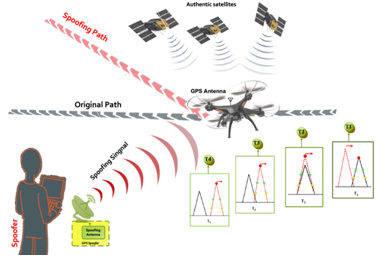Cybersecurity in Space: Protecting Satellites and Space Data with AI
- Shiksha ROY

- May 3
- 4 min read
Updated: May 9
Shiksha Roy | Date: January 21, 2025
In an era where space exploration and satellite technology are integral to global communication, navigation, and scientific discovery, the security of these assets has become a critical concern. Satellites orbiting the Earth are not only pivotal for everyday conveniences like GPS and weather forecasting but also for national security and international cooperation. However, as the reliance on space-based systems grows, so does the threat landscape.

Cyber-attacks targeting satellites and space data can have devastating consequences, disrupting services and compromising sensitive information. To counter these threats, Artificial Intelligence (AI) has emerged as a formidable ally. By leveraging AI's capabilities in threat detection, automated response, and predictive analytics, we can enhance the cybersecurity measures protecting our space infrastructure. This article delves into the role of AI in safeguarding satellites and space data, exploring the technologies and strategies that are shaping the future of cybersecurity in space.
The Growing Importance of Space Cybersecurity
The Critical Role of Satellites
Satellites play a pivotal role in modern life. From enabling global communications and navigation to supporting scientific research and national security, their importance cannot be overstated. A cyber attack on a satellite can have devastating consequences, disrupting essential services and compromising sensitive data.
The Threat Landscape
The space domain faces a myriad of cybersecurity threats, including:
Hacking Attempts:Unauthorized access to satellite systems can lead to data breaches, signal interference, or even loss of control.
Signal Jamming: Malicious actors can disrupt communication links, affecting operations on Earth.
Data Spoofing:Falsified data transmissions can mislead systems and decision-makers, with potentially catastrophic consequences.

Role of Artificial Intelligence in Space Cybersecurity
AI-Powered Threat Detection
AI is highly proficient at processing and interpreting large datasets instantaneously.By leveraging machine learning algorithms, AI can detect anomalous behavior in satellite systems, identify potential cyber threats before they materialize and can also provide insights to mitigate risks proactively.
Enhancing Satellite Communication Security
AI strengthens encryption techniques by generating complex, adaptive algorithms that are resistant to traditional hacking methods. It can also monitor communication channels for unusual patterns, ensuring secure data transmission.
Predictive Analysis
Predictive analytics, powered by AI, enables space agencies and operators to foresee potential vulnerabilities. By analyzing historical data and recognizing trends, AI systems can suggest measures to prevent attacks before they occur.
Autonomous Response Mechanisms
AI can automate responses to cyber threats, minimizing human intervention. For example:
Intrusion Prevention: Automatically isolating compromised systems to prevent the spread of attacks.
System Recovery: Restoring normal operations after a breach with minimal downtime.
Challenges in Implementing AI for Space Cybersecurity
Limited Computational Resources
Satellites often have constrained onboard computing capabilities. Deploying AI solutions that balance efficiency and resource consumption is a significant challenge.
Evolving Threats
Cyber threats are constantly evolving. AI systems must be continually updated and trained to stay ahead of sophisticated attackers.
Data Integrity and Privacy
Ensuring the integrity and privacy of data used to train AI models is critical. Compromised training data can lead to flawed models and vulnerabilities.
Case Studies: AI in Action

GPS Signal Security
AI has been employed to detect and mitigate GPS signal spoofing, ensuring accurate navigation for both civilian and military applications.
Spacecraft Anomaly Detection
AI-driven systems are being used to monitor spacecraft health, identifying anomalies that could indicate cyber-attacks or system malfunctions.
Future Prospects of AI in Space Cybersecurity
Collaborative Efforts
International collaboration will be essential to develop standardized protocols and share threat intelligence for space cybersecurity.
AI and Quantum Computing
The combination of AI and quantum computing holds immense potential for creating unbreakable encryption methods, further bolstering satellite security.
AI-Powered Space Traffic Management
With the increasing number of satellites in orbit, AI can play a crucial role in managing space traffic and preventing collisions caused by cyber interference.
Conclusion
As humanity's dependence on satellite technology continues to grow, the importance of robust cybersecurity measures in space cannot be overstated. Satellites play a crucial role in various aspects of modern life, from communication and navigation to scientific research and national security. However, this reliance also makes them attractive targets for cyber-attacks, which can have far-reaching and potentially catastrophic consequences.Artificial Intelligence (AI) has emerged as a powerful tool in the fight against these cyber threats. By leveraging AI's capabilities in real-time threat detection, automated response, and predictive analytics, we can significantly enhance the security of our space assets.

AI-driven technologies such as machine learning, neural networks, and natural language processing are at the forefront of this effort, providing advanced solutions to detect, respond to, and prevent cyber-attacks on satellites and space data.Despite the challenges and limitations, the future of cybersecurity in space looks promising with continued advancements in AI and increased collaboration among international stakeholders. By working together and embracing innovative technologies, we can create a secure and resilient space environment, ensuring the continued success and safety of space missions for generations to come.
Citations
Maguire, P., & Maguire, P. (2024, May 22). AI at the crossroads of cybersecurity, space and national security in the digital age. SpaceNews. https://spacenews.com/ai-crossroads-cybersecurity-space-national-security-digital-age/?utm_source=chatgpt.com
Wikipedia contributors. (2024, December 2). OPS-SAT. Wikipedia. https://en.wikipedia.org/wiki/OPS-SAT?utm_source=chatgpt.com
Stokel-Walker, C. (2024, October 30). Unspoofable navigation. TIME. https://time.com/7094639/sandboxaq-aqnav/?utm_source=chatgpt.com
Simonelli, C. (2024, November 20). The future of Artificial intelligence in Space: Navigating challenges and opportunities. Space Generation Advisory Council. https://spacegeneration.org/the-future-of-ai-in-space-navigating-challenges-and-opportunities?utm_source=chatgpt.com
Image Citations
Artificial intelligence in space. (n.d.). https://www.esa.int/Enabling_Support/Preparing_for_the_Future/Discovery_and_Preparation/Artificial_intelligence_in_space
A GPS spoofing scenario: Spoofer tries to deviate UAV from the main. . . (n.d.). ResearchGate. https://www.researchgate.net/figure/A-GPS-spoofing-scenario-Spoofer-tries-to-deviate-UAV-from-the-main-trajectory_fig3_352935771
Satellite navigation - GPS - How it works. (n.d.). Federal Aviation Administration. https://www.faa.gov/about/office_org/headquarters_offices/ato/service_units/techops/navservices/gnss/gps/howitworks




Comments